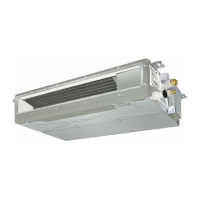
Do you have a question about the Toshiba ras-m16g3dv-e and is the answer not in the manual?
| Technology | Inverter |
|---|---|
| Power Supply | 220-240V, 50Hz |
| Refrigerant | R32 |
| Energy Efficiency Ratio (EER) | 3.5 |
| Coefficient of Performance (COP) | 3.8 |
| Type | Split |
Explains DANGER, WARNING, CAUTION symbols and illustrated marks.
Covers R410A installation, refrigerant, tools, and general safety rules.
Details electrical safety, high voltage dangers, and general warnings.
Covers precautions for water, storage, installation locations, and handling.
Safety precautions for R410A installation and servicing.
Guidelines for installing refrigerant piping with R410A.
Specifies required copper pipes, joints, and processing procedures.
Outlines procedures and precautions for connecting flare joints.
Lists tools specific to R410A and general tools needed.
Step-by-step guide for recharging refrigerant.
Details materials, flux, and brazing techniques for pipes.
Shows external dimensions, mounting points, and component layout.
Illustrates the electrical wiring connections of the unit.
Lists key electrical components and their specifications.
Diagram showing the refrigerant flow in cooling and heating modes.
Illustrates the control system architecture of the indoor unit.
Overview of the air conditioner's control system and components.
Explains controller roles, signals, basic operations, and modes like AUTO, DRY.
Details indoor fan motor control, speed settings, and capacity adjustment.
Covers protective functions, drain pump, after-heat, quiet, Hi-POWER, ECO, and sleep modes.
Explains remote control functions, operation modes, and timer settings.
Covers battery loading, clock setup, and basic remote control operations.
Details settings for AUTO, COOL/HEAT, DRY, Hi-POWER, ECO operations.
Explains temporary operation and setting ON/OFF timers via remote.
Lists locations to avoid for proper indoor unit installation.
Specific considerations for high humidity and required installation space.
General cautions for installation to prevent damage and injury.
Shows external dimensions, mounting points, and component layout.
Procedures for installing hanging bolts and hanging the indoor unit level.
Instructions for reconfiguring air intake and installing the signal receiving unit.
Procedures for installing the receiver into switch boxes or ceilings.
Precautions, materials, and insulation for drain piping.
Details drain hose connection, gravitational drainage, and drainage checks.
Describes drain-up piping and drainage checks after electrical work.
Provides dimensions for manufacturing ducts and connection methods.
Warning about incomplete heat insulation of duct flange and sealing.
Precautions for pipes, flare nuts, size, and length limits.
Details flaring procedures and heat insulation for refrigerant pipes.
Connect wires matching terminal numbers and ensure proper wire margin.
Wiring diagram for optional wired remote controller.
Setting external static pressure and configuring the auto restart feature.
Selecting remote controls and performing test operations.
Initial steps for confirming power, voltage, and normal operation behavior.
Primary judgment methods, LED codes, and remote controller self-diagnosis.
Procedures for inspecting P.C. boards, sensors, and other components.
Step-by-step guide to detach and attach panels and covers.
Procedures for replacing electrical parts box covers, filters, P.C. boards, and reactors.
Instructions for replacing fan cases, motors, drain pumps, and hoses.
Procedures for detaching and attaching the heat exchanger.
Illustrated breakdown of indoor unit components with location numbers.
Detailed list of indoor unit parts with part numbers and quantities.
Illustrated breakdown and list of electronic components.
Procedure to perform a test run operation using the remote controller.
Guide to configuring advanced settings and function codes via the remote.
How to monitor sensor temperatures and operational status.
Accessing and clearing error logs from the remote controller.